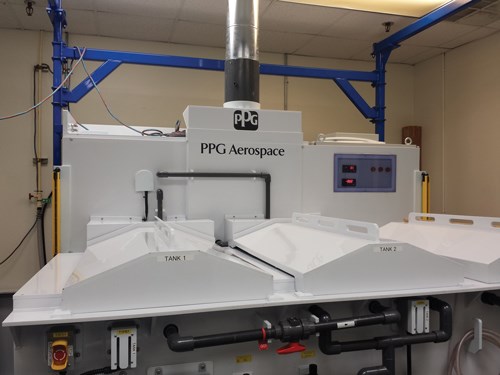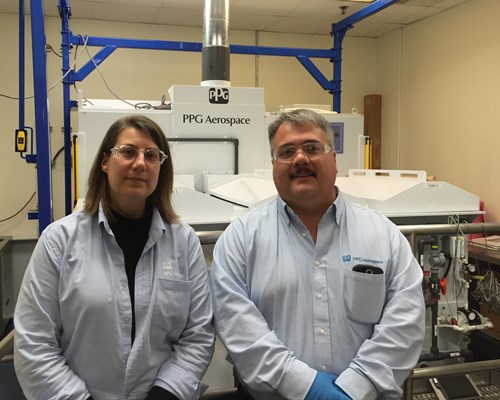PPG Installs E-coat Primer System for Coast Guard
Eco-friendly aerospace primer saves time and weight and enhances corrosion resistance.
PPG Industries’ aerospace coatings group installed the first commercial system in the U.S. for application of its aerospace electrocoat primer to aircraft parts at the U.S. Coast Guard Aviation Logistics Center in Elizabeth City, North Carolina.
The Aviation Logistics Center has reduced primer application and processing time from hours to minutes and full cure time from days to a single hour with PPG’s Aerocron electrocoat primer.
“This is a major step for the U.S. Coast Guard as a trailblazer in this needle-moving technology within the aerospace industry,” says Duane Utter, PPG global segment manager of military aerospace coatings and defense products. “They have processed many parts successfully and are exploring opportunities for additional e-coat applications.”
Primers afford corrosion resistance to metal parts and enhance topcoat adhesion. Utter says that traditional primer is spray-applied, creating overspray and non-uniform film thicknesses that result in lower application efficiencies and higher coating weight.

The PPG aerospace electrocoat primer system at the U.S. Coast Guard Aviation Logistics Center in Elizabeth City, North Carolina, includes a primer dip tank, an immersion-rinse tank, a spray-rinse tank, a cure oven and lab-related equipment.
“The [Aerocron] water-based, chromate-free electrocoat primer produces near-zero waste and affords significant weight savings,” Utter says.
The Coast Guard Aviation Logistics Center used PPG’s chromate-containing aerospace primers and advanced performance top coats when officials asked about the company’s electrocoat technology. After successfully landing a contract, PPG designed a customized system to meet the Coast Guard’s process requirements.
“The transition to using the Aerocron e-coat primer application process is a tremendous advancement from traditional spray primer applications, and will greatly help consumers like the U.S. Coast Guard work toward chromate and waste reduction initiatives,” says Ed Mullins, sales and market development manager at PPG’s Atlanta, Georgia, application support center.

Robin Peffer, research associate at the PPG Coatings Innovating Center in Allison Park, Pennsylvania, and Ed Mullins, sales and market development manager at PPG’s Atlanta, Georgia, application support center, were members of the PPG team that worked with Coast Guard personnel to design a system to meet process requirements.
PPG makes the resin and paste components for Aerocron primer at its Oak Creek, Wisconsin, and Springdale, Pennsylvania, coatings plants. These components are dispersed in water in a dip tank. The system also includes an immersion-rinse tank, a spray-rinse tank, a cure oven and other lab-related equipment.
In addition to this Aerocron primer tank, several pilot and production e-coat tanks have been installed in Europe for evaluation and operation by PPG aerospace coatings customers. The primer is qualified to SAE International’s Aerospace Material Specification 3144 for anodic electrodeposition primer for aircraft applications.
Information for this story supplied by PPG. For more information, please visit ppgaerospace.com
Related Content
-
ECOAT24 Attracts Both Serious Electrocoaters and Novices Alike
The conference, held April 2-4, 2024, in Orlando, Florida, provides the ecoating industry with educational sessions, supplier exhibits and networking with colleagues.
-
Professional Plating Expands Zinc, Ecoat Offerings
Ever expanding, Professional Plating of Brillion, Wisc., has announced two capital investments: a second zinc line and an upgrade of its ecoat capabilities.
-
ECOAT24 Issues Call for Speakers
Don't miss your chance to apply to speak at ECOAT24. Submit your abstract by June 26, 2023.













.jpg;maxWidth=300;quality=90)

